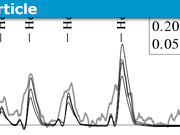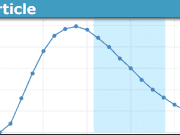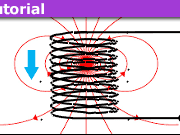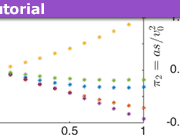Fabry-Perot and Michelson Interferometry: A Fundamental Approach
Table of Contents
Fabry-Perot Effect:
The Fabry-Perot effect is usually treated in most optics textbooks as the interference that results from multiple reflections of the two interfaces of a dielectric slab using a single incident beam.
Michelson Interferometer:
Meanwhile, the interference in the Michelson interferometer is usually described as the interference of a partially transmitted beam through the beamsplitter from one mirror with the partially reflected beam off of the beamsplitter from the other.
Fresnel Coefficients:
The Fresnel coefficients in optics are usually derived with a single incident beam on a single interface and setting the appropriate boundary conditions (that the tangential component of the total electric field is the same on both sides of the dielectric interface) along with conservation of energy. The result of this calculation gives for the Fresnel coefficients that the reflection coefficient ## \rho= \frac{E_r}{E_o}=\frac{n_1-n_2 }{n_1+n_2} ## and transmission coefficient ## \tau=\frac{E_t}{E_o}=\frac{2n_1}{n_1+n_2} ##. In addition an energy reflection coefficient ## R ## can be computed as ## R=\frac{E_r^2}{E_o^2}=\rho^2 ## and energy transmission coefficient ## T=1-R ##.
Fresnel Coefficients to compute the result of two light beams incident on a single dielectric interface:
A very simple but not-so-obvious very important use of the Fresnel coefficients is to apply them to the case of two plane waves incident on a single interface from opposite directions, as we shall see in the discussion below. In the process, the three above items will all be linked together in a way that many interference problems involving dielectric interfaces and beamsplitters, and interferometers can all be treated quantitatively with the same formalism.
The simpler case of a single light beam incident on a single interface can be computed using either Fresnel coefficients or energy coefficients:
The case of a single plane wave incident on a dielectric interface can be treated either by using Fresnel coefficients for the electric field or by simply using energy reflection and transmission coefficients. In a simplified optical system of units, the intensity ## I=n E^2 ##. The incident ## E_o ## can be computed from the incident ## I_o ##. For this case with a single beam, using the Fresnel coefficients takes a little extra work, and oftentimes the energy reflection and transmission coefficients are simply used, where energy reflection coefficient ## R=\rho^2## and energy transmission ## T=1-R ##.
Fresnel Coefficients are necessary to compute the mutually coherent two-beam case:
The problem becomes more complex, but also much more interesting when two (mutually coherent) plane waves are incident on a single interface from opposite directions. The casual observer might ask, why not simply use the energy transmission and reflection coefficients for each beam to get the result? For the incoherent case, this is quite appropriate, but in the case of mutually coherent beams, (and we are assuming perfect alignment and flatness of surfaces, etc. ), these energy coefficients simply are no longer good numbers, even though the Fresnel coefficients remain good numbers. For the system at hand, it behaves completely linearly in the response to the electric field component of the electromagnetic wave, (and thereby the Fresnel coefficients are good numbers), because Maxwell’s equations are linear in the electric field, but this system does not need to respond linearly in its energy properties, because the energy is the second power of the electric field. In this case of two beams, the energy coefficients are totally non-applicable, and the Fresnel coefficients are needed to determine how much energy emerges in each direction from the interface.
A couple of simple examples will first be provided here for the reader. The general case of arbitrary amplitude and phase will then be treated for the case of normal incidence. Following that, the case of the Michelson interferometer will be treated for which both beams have an incident angle of 45 degrees to the beamsplitter. (There is an analogous problem that is applicable with r-f electromagnetic waves on a transmission line from opposite directions where they encounter an interface that has a change in characteristic impedance. For this problem, the same Fresnel coefficients apply with the material indices ## n ## being replaced by ## \frac{1}{Z} ## where ## Z ## is the characteristic impedance, and the electric fields ## E ## replaced by the voltages.)
Calculating the result for two beams of equal intensity in phase with each other at the dielectric interface:
For the first case, we are going to assumes plane waves of equal intensity. One on the left, will begin in air/vacuum with index ## n_1=1 ## , and the one on the right will have its index ## n_2=n_o ## pre-selected so that ## R=1/2 ## , and the Fresnel reflection coefficients are thereby ## \rho_1= -\frac{1}{\sqrt{2}} ## and ## \rho_2=+\frac{1}{\sqrt{2}} ##. A little algebra shows that ## n_o=3+2 \sqrt{2} ##. The Fresnel transmission coefficients are ## \tau_{12}=\frac{2}{1+n_o} ## and ## \tau_{21}=\frac{2n_o}{1+n_o} ##. We’re first going to assume the incident waves are in phase with each other when they encounter the interface, so that no phase terms will need to be included in their amplitudes. The equal intensity of the beams gives the result that ## E_{o1}^2=n_o E_{o2}^2 ## where ## E_{o1} ## and ## E_{o2} ## are the initial electric field amplitudes for the two beams. A little algebra gives the result that ## \tau_{21} E_{o2}=(\frac{2 n_o}{1+n_o})( \frac{ E_{o1}}{\sqrt{n_o}})=\frac{1}{\sqrt{2}} E_{o1} ##. Additionally, the initial ## E_{o1} ## from the left results in ## E_{r1}=\rho_1 E_{o1 }=-\frac{1}{\sqrt{2}}E_{o1} ## and ## E_{t1}=\tau_{12} E_{o1} ##. The initial ## E_{o2} ## from the right becomes a left going ##E_{t2}= \tau_{21} E_{o2} ## and a right going ## E_{r2} =\rho_2 E_{o2}=\frac{1}{\sqrt{2}} E_{o2} ##.Summing components ## E_{total \, emerging \, left}=\rho_1 E_{o1} +\tau_{21} E_{o2}=0 ## and ## E_{total \, emerging \, right}=\tau_{12} E_{o1}+\rho_2 E_{o2}=\sqrt{2} E_{o2} ##. (Note that ##\tau_{12} E_{o1}=\frac{2}{1+n_o}\sqrt{n_o} E_{o2}=\frac{ E_{o2}}{\sqrt{2}} ## as a little algebra and plugging in for ## n_o=3+2 \sqrt{2} ## will show.) This gives the result that ## I_{emerging \, right}=2 n_o E_{o2}^2=I_{total \, initial} ##. The phase change of ## \pi ## that occurs, (essentially a minus sign), upon reflection of the beam from the left off of the higher index material makes it so that its reflected portion precisely cancels the transmitted portion of the beam from the right.
Calculating the result for two beams of equal intensity with ## \pi ## phase difference at the dielectric interface:
The next case that needs to be considered is when there is a phase difference of ## \pi ## between the two incident beams at the interface. In this case it can be shown that ## E_{total \, emerging \, left}=(-)\sqrt{2} E_{o1} ## and ## E_{total \, emerging \, right}=0 ##. In this case ## I_{emerging \, left}=2 E_{01}^2=I_{total \, initial} ##. In this case, the ## \pi ## phase change of the reflected portion of the beam from the left off of the higher index material makes it so that it constructively adds to the transmitted portion of the beam from the right. Meanwhile, the transmitted portion of the beam from the left cancels the reflected portion of the beam from the right (as they both emerge to the right), because neither one undergoes any additional phase change when it encounters or crosses the interface.
Computations for the general case of two beams with arbitrary amplitude and phase:
Both of these cases, (## \phi=0 ## and ## \phi=\pi ## ), can be treated with some very simple algebra without even introducing the sinusoidal form of the traveling waves. For the case of arbitrary phase, it is necessary to include the sinusoidal forms. The algebra is somewhat lengthy, but the general case of arbitrary amplitude and phase along with arbitrary material indices ## n_1 ## and ## n_2 ## for the case of normal incidence will be shown in full detail. The reader is urged to follow the algebra along, at least to a sufficient extent to see the method that the results are calculated.
## E_{total \, emerging \, left}=\rho_1 E_{o1}cos(kx+\omega t)+\tau_{21} E_{o2} cos(kx+\omega t+\phi)=[\rho_1 E_{o1}+\tau_{21}E_{o2}cos(\phi)]cos(kx+\omega t)-[\tau_{21}E_{o2}sin(\phi)](sin(kx+\omega t) ##
and ## E_{total \, emerging \, right}=\rho_2 E_{o2}cos(kx-\omega t+\phi)+\tau_{12} E_{o1} cos(kx-\omega t)=[\rho_2 E_{o2} cos(\phi)+\tau_{12} E_{o1}] cos(kx-\omega t)-[\rho_2 E_{o2} sin(\phi)] sin(kx-\omega t) ##.
This gives ## |E_{total \, emerging \, left}|=[(\rho_1 E_{o1}+\tau_{21} E_{o2} cos(\phi))^2+(\tau_{21} E_{o2} sin(\phi))^2]^{\frac{1}{2}} ## and
## |E_{total \, emerging \ right}|=[(\rho_2 E_{o2} cos(\phi)+\tau_{12} E_{o1})^2+(\rho_2 E_{o2} sin(\phi))^2]^{\frac{1}{2}} ##.
(Here we are using the identity ## |A cos(\omega t)+B sin(\omega t)|=\sqrt{A^2+B^2} ##.)
It is left as an exercise to the reader that this result satisfies conservation of energy, i.e. ## I_{total}=n_1 E_{o1}^2+n_2 E_{o2}^2=n_1 |E_{total \, emerging \, left}|^2+n_2 |E_{total \, emerging \, right}|^2 ##
where ## \rho_1=\frac{n_1-n_2}{n_1+n_2} ## and ## \rho_2=\frac{n_2-n_1}{n_1+n_2} ## and ## \tau_{12}=\frac{2 n_1}{n_1+n_2} ## and ## \tau_{21}=\frac{2 n_2}{n_1+n_2} ##. (This author has worked through the algebra to confirm this conservation of energy.)
Applying the above results to the Michelson interferometer:
Finally, we wish to do the apply this to the case of a Michelson interferometer. One may notice for the Michelson, that difficulty is encountered if one tries to use a symmetric beamsplitter to recombine the beams=it leads to all kinds of contradictions-if interference occurs when one beam is ## \pi ## out of phase with the other, which way does the energy go? Is the one beam ## \pi ## ahead of the other in phase or ## \pi ## behind? , etc… The beamsplitter that is used is a dielectric slab (must be optically flat and faces optically parallel) has an AR (anti-reflection coating on one face). The beamsplitter is thereby asymmetric. The partial reflection and partial transmission occur on the uncoated face. The coated face has zero reflection and 100% transmission. Even at ## 45 ## degree angle of incidence, very similar principles apply that apply at normal incidence. For angles of incidence other than normal incidence, the Kirchhoff relations apply in computing the reflection and transmission coefficients. These are also polarization-dependent. One detail is the refraction that occurs, i.e. inside the material it will not have angle of incidence of 45 degrees,but in fact, when the external ## \rho=-\frac{1}{\sqrt{2}} ##, this internal ## \rho=+\frac{1}{\sqrt{2}} ##. One other item is the composite transmission ## \tau_{composite} ## through both faces of the beamsplitter will be ## \tau_{composite}=+\frac{1}{\sqrt{2}} ##. This actually simplifies many of the computations. One other item that should be mentioned is in the Michelson, the beamsplitter is employed twice=once to split the beam, and a second time to recombine the beams. The Michelson could be reconfigured to have two beamsplitters, one for each use, and it would be doing the very same operation. It should be recognized that a beamsplitter such as that of the Michelson interferometer can be used to (re)combine two mutually coherent plane waves with 100% energy conservation.
It is rather remarkable that if one blocks the beam returning from one of the mirrors in the Michelson interferometer, the beam energy from the other mirror will get split equally between the two receivers, but when the second beam is unblocked, the energy will be distributed between the two receivers in a phase-dependent manner that is completely conserving in energy. By proper choice of phase, all of the energy may go to one or the other receiver. The same is the case for the two beams incident upon the dielectric interface from opposite directions.
Discussion of the r-f case:
The above theory applies to the case of two sinusoidal r-f voltage signals traveling on a transmission line from opposite directions and incident on an interface where the characteristic impedance changes. In this case, the same reflection and transmission coefficients apply with ## n_1 ## replaced by ## \frac{1}{Z_1} ##, and ## n_2 ## replaced by ## \frac{1}{Z_2} ##, and the electric fields ## E ## replaced by voltages. The power/intensity ## I=n E^2 ## then of course becomes the very familiar ## \frac{V^2}{Z} ##. The same theory will even work for the case of two voltage pulses on a transmission line, and the case of a ## \pi ## phase change is that of a pulse of negative voltage. (In the r-f case, I don’t think they call the reflection and transmission coefficients “Fresnel” coefficients, but the very same equations apply with the above replacements.
B.S. Physics with High Departmental Distinction= University of Illinois at Urbana-Champaign 1977. M.S. Physics UCLA 1979. Worked for 25+ years as a physicist doing electro-optic research at Northrop-Grumman in Rolling Meadows, Illinois.








Here is another posting of a homework question that came up involving the Michelson interferometer, and the sodium doublet at 589.0 and 589.6 nm. It is a little simpler than the homework question of post 13. https://www.physicsforums.com/threads/interferometer-2-spectral-lines.944019/#post-5973375
An additional item came up in another post today, https://www.physicsforums.com/threads/interference-puzzle.942715/#post-5963655 , where a beamsplitter can be half-silvered, and the result is a ## +pi/2 ## phase change that occurs on both reflections. The reason for a phase change of ## pi/2 ## that occurs between transmitted and reflected beams seems to be of quantum mechanical origins, (see the discussion in the thread along with the "links" supplied in the discussion). ## \ ## In any case, upon introducing this ## +pi/2 ## phase shift on both reflected beams, interference along with conservation of energy is found to occur, just as in the case treated in this Insights article of the dielectric beamsplitter that has phase shifts of ## pi ## and zero for the reflections, external and internal, off of the uncoated (no anti-reflection coating) face of the dielectric beamsplitter. Upon introducing the ## + pi/2 ## phase shifts for the half-silvered beamsplitter, the rest of the calculation for the resulting energy distribution proceeds just as in the purely classical case.
A student just posted a homework question involving the Michelson interferometer in the form where the source is a diffuse source rather than a plane wave. The concepts presented in this Insight article are still relevant, and anyone with an interest in interferometry may find this homework question of interest: https://www.physicsforums.com/threa…michelson-interferometer.933638/#post-5902650
btw, Charles just published his second Insight here:
https://www.physicsforums.com/insights/permanent-magnets-ferromagnetism-magnetic-surface-currents/
[QUOTE="vanhees71, post: 5664358, member: 260864"]That's a very nice Insights article![/QUOTE]Thank you [USER=260864]@vanhees71[/USER]
That's a very nice Insights article!
[QUOTE="houlahound, post: 5657309, member: 551046"]I think microwave speed detectors for police use are obsolete. They have laser systems now. From what I can tell.What you said prolly still holds tho.[/QUOTE]I should point out that for the case of the moving Michelson mirror, there are two ways of analyzing the system that yield identical results: 1) As the interference of the two signals that causes constructive or destructive interference with the result changing with time because of the changing relative phase of the two signals 2) As a frequency shift (Doppler shift) of the returning signal from one of the mirrors.
I think microwave speed detectors for police use are obsolete. They have laser systems now. From what I can tell.What you said prolly still holds tho.
Just one additional comment that doesn't need to be part of the article: I believe the radar that the police use is essentially a Michelson type configuration, possibly with microwaves, where the vehicle being measured for its speed is basically one of the Michelson mirrors. The sinusoidal signal returns with a Doppler shift that is heterodyned with the internal reference signal. For microwaves, an optical type beamsplitter would not be necessary, but otherwise, the principles are similar.
[QUOTE="houlahound, post: 5657205, member: 551046"]That would be good to edit into the original article, not everyone will see your last post.[/QUOTE]Thank you [USER=551046]@houlahound[/USER] I took your suggestion and added a paragraph at the bottom. :)
That would be good to edit into the original article, not everyone will see your last post.
Perhaps one thing worth mentioning in more detail that I only included in one sentence in the article is that it can also be applied to sinusoidal r-f voltage signals traveling on a transmission line and incident on an interface where the characteristic impedance changes. The same reflection and transmission coefficients apply with ## n_1 ## replaced by ## frac{1}{Z_1} ##, and ## n_2 ## replaced by ## frac{1}{Z_2} ##, and the electric field ## E ## replaced by voltages. (In the r-f case I don't think they call them "Fresnel" coefficients, but the equations are the same with the replacement just mentioned. And of course the energy/power goes as ## V^2/Z ## ) .It will even work for two voltage pulses traveling on a transmission line. Instead of having the signals ## pi ## out of phase, one of them can be a pulse with a negative voltage. [USER=43978]@Dale[/USER] I think you are an electrical engineer=perhaps you would find the r-f case of interest.
Great first Insight Charles!
Only skimmed ATM, looks like another great insight.Thanks.